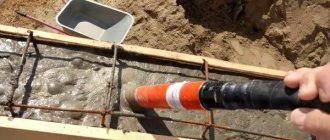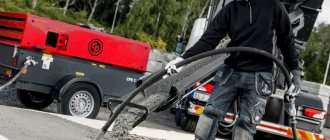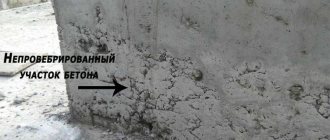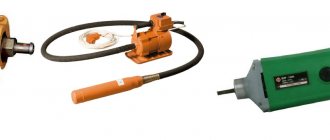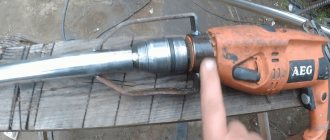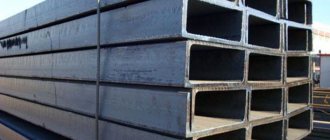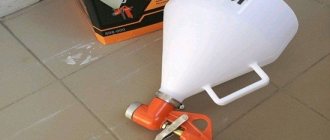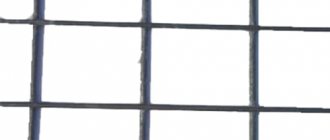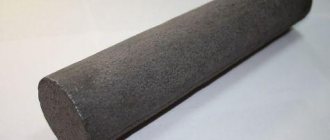The use of a concrete vibrator during laying is a necessary condition for obtaining the design characteristics of the material.
Regardless of the mixing method, freshly poured concrete contains air bubbles, “excess” moisture, and heterogeneous fragments. You can give a monolith density and brand strength using different compaction methods, one of them is vibration.
What's happened?
So, an internal vibrator is an important tool for a construction worker. Basically, it has an electric drive, which makes it light and easy to carry. Two people are involved in working with a deep vibrator.
One holds the drive itself, the other lowers the main mechanism of the tool into the concrete. If we consider the design of a typical vibrator, it always consists of a drive, a flexible tip and an immersed part in the form of a flexible shaft. The operating principle of the device is simple.
Voltage is supplied to the drive motor, which provides torque to the flexible shaft, at the end of which there is an eccentric. The eccentric rotates, hits the walls of the submersible tip body, creating a vibration that destroys the voids inside the poured concrete, which leads to air escaping to the surface.
Concrete vibration process
to use a 220V deep vibrator in your work, especially in the corners, since this is where cracks often form. In addition, the vibrator assumes the formation of a smooth concrete surface, uniform settling of the filler, which is gravel, quartzite, granite, expanded clay and other filling options.
This allows the contents to be evenly distributed throughout the foundation structure, which increases the ability to withstand heavy loads. I would like to note that such a tool is rarely used to process the surface of the base. In this case, a vibrating screed is used. It is laid on the concrete surface and specialists stretch it across the entire area. Due to vibration, the surface is leveled and becomes smooth.
Purpose
The prepared concrete solution, despite thorough mixing, remains heterogeneous, which reduces the characteristics of the monolith. In addition to cement laitance, crushed stone and sand, it contains water and air bubbles.
If concrete is simply poured into the formwork, the result will be a structure that is heterogeneous in structure. The use of a vibration compactor for concrete increases the fluidity of the mixture without additional additives, due to the movement of its components. Air inclusions are pushed onto the surface of the monolith, and the fillers are evenly distributed throughout the volume.
After vibration compaction, the volume of concrete poured into the formwork is reduced by 30%. This effect occurs due to getting rid of air-filled voids and more dense packing of sand and crushed stone. As a result, the strength of the massive structure reaches its maximum value and high density for a given grade of concrete.
Description and characteristics
The deep vibrator is generally light and has small dimensions, but it is better for two people to work with it. As we said earlier, the first worker will hold the tool itself and bring it to the desired place, and the second will pierce the concrete base using a submersible flexible shaft. As for selection issues, it is important to determine the characteristics of the tool, since they are fundamental. I would like to highlight the following characteristics:
1. Engine power. Each drive has a motor inside it. Here they divide models into household and professional. For models for domestic use, the power should not exceed one and a half kW. At the same time, less than 0.75 kW will also not be enough for domestic needs. For industrial operating conditions, a heavier and more powerful vibrator is required, with a power limit of 3 to 4 kW, inclusive.
2. Flexible shaft. It must have a length that will be greater than the size of the formwork, taking into account the depth of the foundation. Take the tool with a reserve. If your foundation has a depth of about 1 m, plus formwork, then you need to choose a flexible shaft length of at least 2 m.
From this point of view, it is convenient to rent a deep vibrator from those who have many different varieties. The vibrator is often used in layers. This is due to the fact that the depth tip can be of a fixed, small size. At the same time, when immersed in concrete, it should stick out slightly above the surface. Thus, another selection criterion is the length of the tip.
3. Tip diameter. This criterion is no less important. The tip is also called a mace. If we work with a larger diameter, we can process a larger volume of concrete in a short period of time. It is worth considering that during one immersion during vibration, no more than 10-12 cm in diameter is processed around even the thickest tip.
Therefore, even the thickest tip should be reusable over the entire base area. The work is difficult and requires a lot of effort, but you can guarantee the quality of the foundation.
4. Frequency of eccentric oscillations. This criterion even depends directly on the type of concrete you will use. Any concrete has a concept of grain size. This is due to the quality of the filler and the fraction used. Therefore, if you use coarse-grained concrete, it is better to use a low-frequency tool in your work, where the vibration value does not exceed 3500 in one minute.
As for high-frequency tools, they will work best with fine-grained concrete. If you are buying a tool for your home, it is best to pay attention to models with intermediate vibration values. This will help ensure that air is removed from the monolith or tape-type base.
5. Weight of the product. We said earlier that the weight is light. This applies to average models for household use. But, if we are talking about a professional tool, then its weight can reach 100 kg. This vibrator is equipped with a transportation system, and it must be rolled along the poured base. It must be emphasized that household tools weigh no more than 6-8 kg.
Types of vibrators for concrete and criteria for their selection
First, let's look at the general characteristics that are relevant when choosing both deep and surface devices.
What all vibrators for concrete compaction have in common
| Parameter | Meaning | Note |
| type of drive | electric | The most popular solution, because You can work with such devices in almost any environment, including indoors. They are inferior to models with gasoline (diesel) drive in terms of power and autonomy. |
| petrol/diesel | Powerful industrial vibrators with a high degree of mobility. | |
| pneumatic | The use of a compressor is relevant for the most part in the conditions of reinforced concrete plants. | |
| Power | low and medium power | up to 2000 W. Household or for local use in construction. Lightweight, portable, affordable. |
| professional | 2000-4000 W. Adapted for continuous use when pouring reinforced concrete products and monolithic construction, designed for long-term operation. | |
| Vibration frequency and amplitude | low frequency | up to 3.5 thousand vibrations/min. Due to the low frequency and large amplitude of vibrations, they are adapted for working with slow-moving, coarse-grained types of concrete. |
| mid-frequency | from 3.5 to 10 thousand vibrations/min. The most universal option if work is carried out with concrete of varying degrees of mobility. | |
| high frequency | more than 10 thousand vibrations/min. It is characterized by high frequency and low amplitude of vibrations, due to which it is the optimal solution for moving fine-grained concrete. | |
| Weight | up to 6 kg | This parameter is largely determined by the scope of application of the units and depends on their power. The weight of portable devices for household use usually does not exceed 5-6 kg, while industrial equipment can reach a weight of 100 kg. |
| 6-20 kg | ||
| more than 20 kg |
Now let's try to understand the features of choosing deep-type devices.
They are the most popular solution for pouring reinforced concrete structures. Data for selecting submersible models
| Parameter | Meaning | Note |
| Shaft length | 0.5-20 m | The length of the shaft is selected based on the thickness of the concrete mixture with a margin of 1 m. This simple rule is dictated by common sense and the efficiency of using equipment in various conditions. Long shafts up to 15-20 m in size are used for pouring reinforced concrete supports, 2-5 m is usually sufficient for pouring foundations, and short shafts (0.5-1 m) are used for compacting floors. |
| Club diameter* | 25-110 mm | The diameter of the vibrating tip (club) is selected based on the density of the reinforcement. Usually, for reinforced structures, preference is given to 25 mm products, but if the reinforcement is rare or not used, then a tip of 76 mm or more can be used, because in this case, the efficiency of vibration compaction increases, and the labor intensity of the process decreases. |
* keep in mind that the tip gets very hot during operation - this is normal, just be careful.
Well, if you decide to purchase a surface vibration compactor, then when choosing you need to take into account the following features, which mostly relate to the equipment.
Data for selecting external type equipment
| Parameter | Meaning | Note |
| Mounting feature | vice | This method is used for structures with high density reinforcement if vibration spreads within a radius of 0.25-0.8 m from the vibrator. Fastening with a vice to the formwork posts is carried out using a clamp or worm screw. |
| chain grip | This approach is relevant when working with structures of small thickness when using vibration compactors with a radius of action of up to 0.25 m. |
It is worth noting that the effective range of both equipment options usually does not exceed 0.5 m. This suggests that the step of rearranging deep vibrators should not exceed this value.
Accessories and spare parts
For the most part, this question concerns immersion-type equipment, in which flexible shafts and tips are consumables. Most often, the manufacturer offers a set of shaft and club for full compatibility of components. The cost of such products depends on their parameters, for example, the diameter of the tip and the length of the flexible shaft.
Kinds
As for the varieties, here the vibrator is represented by four main modifications. This concerns the principle of operation of the device, where electric type vibrators are most often found. They are easy to use, weigh less, but at the same time develop the required amount of eccentric vibrations.
In the electric modification, an important link is the electric motor, the power of which varies up to 4 kW, depending on whether the model is amateur or professional. Another type is pneumatic. It is not used for domestic needs, since this type of design and method of operation of the device requires the presence of an additional installation that will create air pressure.
The device is difficult to use, but has a fairly high efficiency. Diesel and gasoline vibrators are two more varieties on sale. These devices are autonomous, although they are the heaviest among the electrically driven varieties. Diesel engines are even cheaper, since they consume less fuel, and it costs a little less than the cost of gasoline.
By drive type
The engine is one of the main components of the vibrator.
Based on the type of drive, vibrators are distinguished:
Electromechanical.
Tied to the electrical network - single-phase (220 V) or three-phase network (380) - they have limited mobility. 220 V manual concrete vibrators do not require any special conditions, but do not provide much power. Models with a three-phase motor are more powerful, but heavier and more difficult to connect;
Compact submersible vibratory compactors are mobile - they are battery-powered (often powered from the mains is also provided). Disadvantages - limited operating time by the battery capacity and low power. Regardless of the price, compact models are intended for domestic use and do not involve processing large volumes of concrete.
Based on an internal combustion engine - gasoline or diesel.
The vibrators do not depend on the electrical network and have a power of up to 4 kW - this is enough for vibration processing of large-volume concrete masses. Disadvantages - large dimensions and weight, difficulty of maintenance.
There are portable models of gasoline vibrators for concrete. They are mobile - the engine fits in a backpack. However, they are more expensive than stationary ones, and the power usually does not exceed 2 kW.
Pneumatic.
The oscillatory force is created by supplying a stream of compressed air from the compressor. Pneumatic vibrators are used in industrial conditions - they have a long service life, are explosion- and electrically safe, do not require complex maintenance, and can operate in humid and dusty conditions. The main area of application is the production of reinforced concrete products.
Based on power, we can conditionally distinguish vibrators:
- household - up to 2 kW. These are stationary or more convenient (and expensive) portable models - working with them does not require special knowledge and experience;
- professional – up to 4 kW. Heavy and, as a rule, stationary models, the maintenance of which requires special skills. Such vibrators are used for laying concrete in multi-story and industrial construction, and in the production of reinforced concrete.
